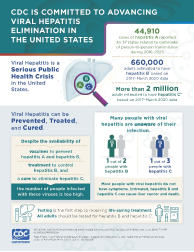About the Division of Viral Hepatitis
The Division of Viral Hepatitis (DVH) is part of the National Center for HIV, Viral Hepatitis, STD, and TB Prevention at CDC. DVH consists of three branches —Epidemiology and Surveillance, Prevention, and Laboratory— that work collaboratively with the aim of ending the viral hepatitis epidemics by providing leadership in science and public health practices.
CDC is committed to advancing viral hepatitis elimination in the United States. Learn more. [PDF – 4 MB]
Division of Viral Hepatitis (DVH) Strategic Plan
DVH’s 2025 Strategic Plan [PDF – 3.2 MB] outlines goals, strategic approaches, objectives, and outcome measures for making measurable progress in reducing new viral hepatitis infections and viral hepatitis-associated illnesses, deaths, and disparities in the United States over the next five years. In developing 2025 outcome measures for this strategic plan, DVH was mindful of existing global goals to eliminate viral hepatitis as a public health threat by 2030, while also recognizing that new cases of viral hepatitis in the United States continue to rise. Progress towards 2030 goals require changing this trajectory; therefore, gains made between now and 2030 are not expected to be achieved linearly. Accordingly, DVH has established incremental yet robust outcome measures for 2025.
DVH’s 2025 Strategic Plan shares many of the goals and priorities of the HHS National Viral Hepatitis Action Plan 2017-2020 and also aligns with the NCHHSTP Strategic Plan Through 2020.
Division of Viral Hepatitis Strategic Plan Snapshot
2025 Strategic Plan Goals:
Outcome Measures — reduce estimated new:
- HAV infections from 6,700 in 2017 to ≤ 4,000 in 2023 and ≤ 2,500 in 2028
- HBV infections from 22,200 in 2017 to ≤ 18,000 in 2023 and ≤ 2,200 in 2028
- HCV infections from 44,700 in 2017 to ≤ 35,000 in 2023 and ≤ 4,400 in 2028
Outcome Measures—reduce reported rate of:
- Hepatitis B-related deaths per 100,000 population from 0.46 in 2017 to ≤ 0.37 in 2023 and ≤ 0.16 in 2028
- Hepatitis C-related deaths per 100,000 population from 4.13 in 2017 to ≤ 3.00 in 2023 and ≤ 1.44 in 2028
Outcome Measures—reduce reported rate of:
- New HBV infections among PWID* per 100,000 population from 1.4 in 2017 to ≤ 1.0 in 2023 and ≤ 0.1 in 2028
- New HCV infections among PWID* per 100,000 population from 2.3 in 2017 to ≤ 1.7 in 2023 and ≤ 0.2 in 2028
- Hepatitis B-related deaths among A/PIs per 100,000 population from 2.45 in 2017 to ≤ 1.84 in 2023 and
≤ 0.86 in 2028 - Hepatitis C-related deaths among AI/ANs per 100,000 population from 10.24 in 2017 to ≤ 7.17 in 2023 and
≤ 3.58 in 2028 - Hepatitis C-related deaths among non-Hispanic Blacks per 100,000 population from 7.03 in 2017 to ≤ 4.92 in
2023 and ≤ 2.46 in 2028
Outcome Measures—increase the proportion of:
- Funded jurisdictions that report all viral hepatitis notifiable conditions to CDC to 90% by 2025
- Funded jurisdictions that meet CDC quality standards for completeness and timeliness to 90% by 2025
- Funded jurisdictions that have analyzed and disseminated surveillance data for public health action to 90% by 2025
- All viral hepatitis clusters/outbreaks that are reported to CDC within 30 days to 90% by 2022
HAV = hepatitis A virus; HBV = hepatitis B virus; HCV = hepatitis C virus; PWID = people who inject drugs; A/PIs = Asians and Pacific Islanders; AI/ANs = American Indians and Alaska Natives; *18-40 year-olds serve as a proxy for PWID.
Download the printable version [PDF – 252 KB] of the snapshot.
